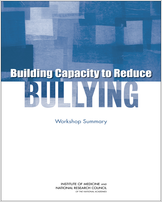NCBI Bookshelf. A service of the National Library of Medicine, National Institutes of Health.
Bullying—long tolerated as just a part of growing up—finally has been recognized as a substantial and preventable health problem. Bullying is associated with anxiety, depression, poor school performance, and future delinquent behavior among its targets, and reports regularly surface of youth who have committed suicide at least in part because of intolerable bullying. Bullying also can have harmful effects on children who bully, on bystanders, on school climates, and on society at large. Bullying can occur at all ages, from before elementary school to after high school. It can take the form of physical violence, verbal attacks, social isolation, spreading rumors, or cyberbullying. Increased concern about bullying has led 49 states and the District of Columbia to enact anti-bullying legislation since 1999. In addition, research on the causes, consequences, and prevention of bullying has expanded greatly in recent decades. However, major gaps still exist in the understanding of bullying and of interventions that can prevent or mitigate the effects of bullying.
Building Capacity to Reduce Bullying is the summary of a workshop convened by the Board on Children, Youth, and Families of the Institute of Medicine and National Research Council in April 2014 to identify the conceptual models and interventions that have proven effective in decreasing bullying, examine models that could increase protective factors and mitigate the negative effects of bullying, and explore the appropriate roles of different groups in preventing bullying. This report reviews research on bullying prevention and intervention efforts as well as efforts in related areas of research and practice, implemented in a range of contexts and settings, including schools, peers, families, communities, laws and public policies, and technology. Building Capacity to Reduce Bullying considers how involvement or lack of involvement by these sectors influences opportunities for bullying, and appropriate roles for these sectors in preventing bullying. This report highlights current research on bullying prevention, considers what works and what does not work, and derives lessons learned.
Contents
- THE NATIONAL ACADEMIES
- PLANNING COMMITTEE ON INCREASING CAPACITY FOR REDUCING BULLYING AND ITS IMPACT ON THE LIFECOURSE OF YOUTH INVOLVED
- Reviewers
- 1. Introduction and Overview
- I. Understanding Bullying
- II. Contexts for Prevention and Intervention
- III. Future Directions and Overall Themes
- Appendixes
Rapporteurs: Patti Simon and Steve Olson.
This activity was supported by Contract No. HHSH250200976014I/HHS25034018T between the National Academy of Sciences and the Health Resources and Services Administration of the U.S. Department of Health and Human Services. The views presented in this publication do not necessarily reflect the views of the organizations or agencies that provided support for the activity.
Suggested citation:
IOM (Institute of Medicine) and NRC (National Research Council). 2014. Building capacity to reduce bullying: Workshop summary Washington, DC: The National Academies Press.
NOTICE: The workshop that is the subject of this workshop summary was approved by the Governing Board of the National Research Council, whose members are drawn from the councils of the National Academy of Sciences, the National Academy of Engineering, and the Institute of Medicine.
- NLM CatalogRelated NLM Catalog Entries
- Identifying and Addressing Bullying.[StatPearls. 2024]Identifying and Addressing Bullying.Waseem M, Nickerson AB. StatPearls. 2024 Jan
- Review School bullying: its nature and ecology.[Int J Adolesc Med Health. 2011]Review School bullying: its nature and ecology.Espelage DL, De La Rue L. Int J Adolesc Med Health. 2011 Nov 4; 24(1):3-10. Epub 2011 Nov 4.
- Bullying, psychosocial adjustment, and academic performance in elementary school.[Arch Pediatr Adolesc Med. 2005]Bullying, psychosocial adjustment, and academic performance in elementary school.Glew GM, Fan MY, Katon W, Rivara FP, Kernic MA. Arch Pediatr Adolesc Med. 2005 Nov; 159(11):1026-31.
- Review Translating research to practice in bullying prevention.[Am Psychol. 2015]Review Translating research to practice in bullying prevention.Bradshaw CP. Am Psychol. 2015 May-Jun; 70(4):322-32.
- Extending the school grounds?--Bullying experiences in cyberspace.[J Sch Health. 2008]Extending the school grounds?--Bullying experiences in cyberspace.Juvonen J, Gross EF. J Sch Health. 2008 Sep; 78(9):496-505.
- Building Capacity to Reduce BullyingBuilding Capacity to Reduce Bullying
Your browsing activity is empty.
Activity recording is turned off.
See more...
